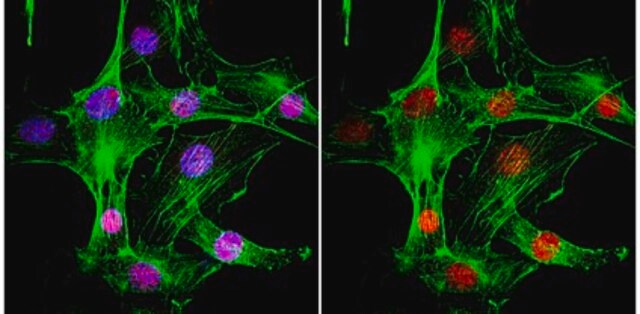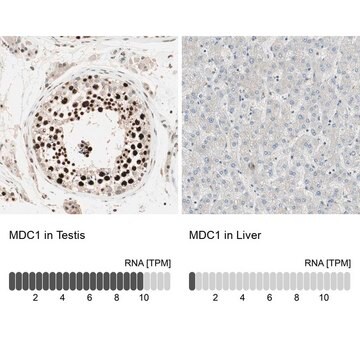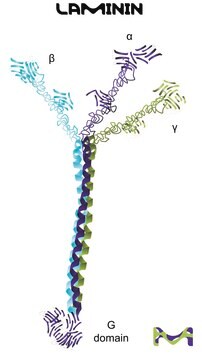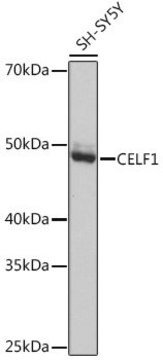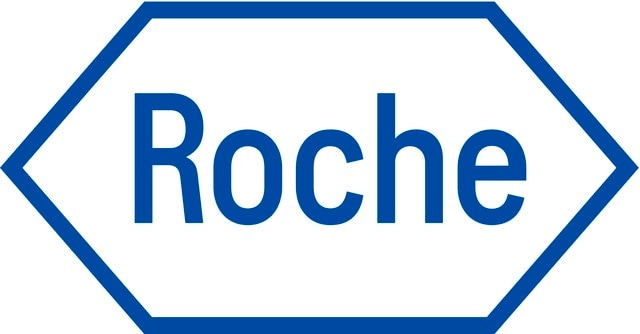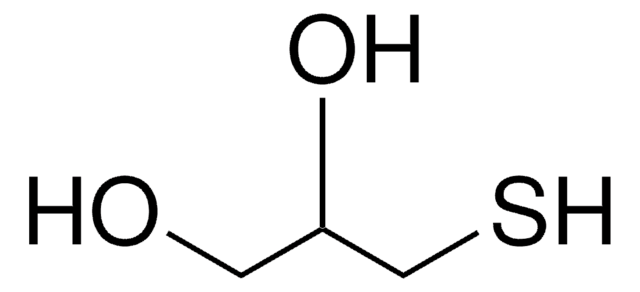추천 제품
생물학적 소스
mouse
Quality Level
결합
unconjugated
항체 형태
purified from hybridoma cell culture
항체 생산 유형
primary antibodies
클론
MDC1-50, monoclonal
양식
buffered aqueous solution
분자량
antigen ~250 kDa (2-3 bands)
종 반응성
monkey, human
포장
antibody small pack of 25 μL
기술
immunocytochemistry: suitable
immunoprecipitation (IP): suitable
microarray: suitable
western blot: 1-2 μg/mL using total cell extract of G361 cells
동형
IgG2a
UniProt 수납 번호
배송 상태
dry ice
저장 온도
−20°C
타겟 번역 후 변형
unmodified
유전자 정보
human ... MDC1(9656)
일반 설명
Monoclonal Anti-MDC1 (mouse IgG2a isotype) is derived from the hybridoma produced by the fusion of mouse myeloma cells (NS1 cells) and splenocytes from BALB/c mice immunized with a recombinant human MDC1 fragment. Mediator of DNA damage checkpoint protein 1 (MDC1) contains 2089 amino-acid residues with a predicted molecular weight of 226.4 kDa. The protein contains an FHA (forkhead-associated) domain at its amino terminus and two BRCT (BRCA1 carboxyl terminal) domains at its carboxy terminus.
특이성
Mouse monoclonal clone MDC1-50 anti-MDC1 antibody recognizes human and monkey MDC1.
면역원
recombinant human MDC1 fragement (amino acids 2-200).
애플리케이션
Monoclonal Anti-MDC1 antibody produced in mouse has been used in:
- enzyme-linked immunosorbent assay (ELISA
- immunofluorescence
- western blotting
- immunoprecipitation
- immunocytochemistry
Mouse monoclonal clone MDC1-50 anti-MDC1 antibody is used to tag mediator of DNA damage checkpoint protein 1 for detection and quantitation by Western blotting and immunohistochemical (IHC) techniques such as ELISA, immunoblotting (approx. 250 kDa, 2-3 bands), immunoprecipitation and immunocytochemistry. It is used as a probe to determine the roles of mediator of DNA damage checkpoint protein 1 in DNA repair and genomic stability.
생화학적/생리학적 작용
Genomic instability caused by the disruption of mechanisms that regulate cell-cycle checkpoints, DNA repair and apoptosis may lead to the development of cancer. ATM and ATR protein kinases are mediated to DNA damage sites by molecular adapters or mediators proteins such as Histone H2AX, Claspin and BRCTmotif containing molecules such as 53BP1, BRCA1, and MDC1 (mediator of DNA damage checkpoint protein 1). MDC1 interacts with the MRE11 complex (containing MRE11, RAD50 and NBS1 proteins). The MRE11 complex is involved in the detection repair and signaling of DNA damage. Upon ionizing radiation MDC1 is hyperphosphorylated by ATM and localizes to nuclear foci together with the MRE11 complex, phosphorylated H2AX and 53BP1. A radio resistant DNA synthesis (RDS) phenotype in cells is formed by down regulation of MDC1 protein expression by siRNA.
물리적 형태
Solution in 0.01 M phosphate buffered saline, pH 7.4, containing 15 mM sodium azide.
면책조항
Unless otherwise stated in our catalog or other company documentation accompanying the product(s), our products are intended for research use only and are not to be used for any other purpose, which includes but is not limited to, unauthorized commercial uses, in vitro diagnostic uses, ex vivo or in vivo therapeutic uses or any type of consumption or application to humans or animals.
적합한 제품을 찾을 수 없으신가요?
당사의 제품 선택기 도구.을(를) 시도해 보세요.
Storage Class Code
10 - Combustible liquids
WGK
WGK 2
Flash Point (°F)
Not applicable
Flash Point (°C)
Not applicable
가장 최신 버전 중 하나를 선택하세요:
시험 성적서(COA)
Lot/Batch Number
53BP1 nuclear bodies form around DNA lesions generated by mitotic transmission of chromosomes under replication stress
Lukas C, et al.
Nature Cell Biology, 13(3), 243-243 (2011)
Helen C Turner et al.
Radiation and environmental biophysics, 53(2), 265-272 (2014-01-31)
At the Center for High-Throughput Minimally Invasive Radiation Biodosimetry, we have developed a rapid automated biodosimetry tool (RABiT); this is a completely automated, ultra-high-throughput robotically based biodosimetry workstation designed for use following a large-scale radiological event, to perform radiation biodosimetry
J M Bradbury et al.
Biochemical Society transactions, 31(Pt 1), 40-44 (2003-01-28)
To maintain genomic stability, despite constant exposure to agents that damage DNA, eukaryotic cells have developed elaborate and highly conserved pathways of DNA damage sensing, signalling and repair. In this review, we concentrate mainly on what we know about DNA
A dual interaction between the DNA damage response protein MDC1 and the RAG1 subunit of the V (D) J recombinase
Coster G, et al.
The Journal of biological chemistry, 287(43), 36488-36498 (2012)
DICER, DROSHA and DNA damage response RNAs are necessary for the secondary recruitment of DNA damage response factors
Francia S, et al.
Journal of Cell Science, 129(7), 1468-1476 (2016)
자사의 과학자팀은 생명 과학, 재료 과학, 화학 합성, 크로마토그래피, 분석 및 기타 많은 영역을 포함한 모든 과학 분야에 경험이 있습니다..
고객지원팀으로 연락바랍니다.